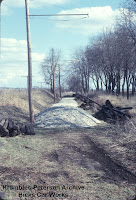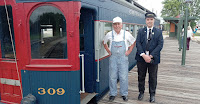Many thanks to Art Peterson, who has sent along another terrific trove of photos. In this case, they're from a railway familiar to us all: IRM itself, taken in the early years in Union between 1964 and 1970. Some photos were taken by a young Art Peterson himself. Enjoy!
News and views of progress at the Illinois Railway Museum
Saturday, June 29, 2024
IRM Before 1970
Posted by
Frank Hicks
at
8:00 AM
2
comments
![]()
Labels: Krambles-Peterson Archive, Nostalgia
Friday, June 28, 2024
Thursday Brief
Weekday service continues on a regular basis during the summer, of course. Thanks to the many volunteer regulars who make this possible. This year we're trying to have two cars operating each day, one on the loop and one on the main line.
On Thursday I was able to spend a day running the 714 in mainline service.
And here's a relatively new regular: Jim Ward, who was running the 3142.
Posted by
Randall Hicks
at
8:58 AM
0
comments
![]()
Thursday, June 27, 2024
Illinois Terminal Class B
Gregg Wolfersheim reports on his latest project: the Illinois Terminal Class B!
Now that I'm finished with the line car, I've found a few other things that need attention. Many years ago the Class 'B', 1565 got a new canvas roof. At the time the locomotive sat outside. Probably to prevent any leaks from rain, the smoke jack was never reinstalled. I found some of the components and put it back together. Here is a photo of the outside. The gray primer will get "roof red" some day.
Posted by
Randall Hicks
at
9:22 PM
0
comments
![]()
Monday, June 24, 2024
Sunday Part II
Frank writes...
A lightning strike Saturday night had blown some lightning arrestors and fuses, so the 3142 was the first car out of the barn but it was commandeered by Greg Kepka, who was up at the crack of dawn to fix the signals and needed a conveyance out to address some issues toward the east end. Thanks, Greg! As such, the 18 was the only streetcar on the car line for an hour or two, until the 3142 returned from its (rare) main line trip and the 141 went into service.
My conductor for the day was Keith Letsche, visible above at his station. He did quite a bit of research into the 18, the Shaker Heights line, and the eccentric Van Swearingen brothers, which I greatly appreciate. Our riders got some pretty unique history about the 18 and the origins of the Shaker Heights line.
Here we are at Depot Street with the IT train in the background. For most of the day the main line trains were the "Tangerine Flyer," IT 101, North Shore 714 and 749, and ComEd 4 pulling the coach train.
Late in the afternoon, Harold snagged a slot for the 309 to make one full main line trip, so it's shown here on track 1 with our three-car IT train on track 2. Pretty snazzy!
Posted by
Frank Hicks
at
9:17 PM
2
comments
![]()
Labels: 18 Operation
Sunday, June 23, 2024
Trolley Sunday
Sunday was another busy day for Trolley Weekend, and everything went smoothly. I was running the 309, so I didn't get many pictures. Keep those cards and letters coming, folks!
The 309 was in Jefferson Shuttle service all day. That worked out well and we had a good time. Most of the trips had a good number of passengers. And here's the crew:
Posted by
Randall Hicks
at
8:16 PM
0
comments
![]()
Labels: 309 operation
Saturday, June 22, 2024
Trolley Weekend
This weekend there's no annoying fumes or smoke, we're all electric. Most of the operable cars will be in service at some point during these two days, so try not to miss it. As an opener, here's what was going on Saturday morning!
First of all, our oldest operating car, the 24, built in 1898.
Nick proudly stands on the platform. This car was running in Jefferson shuttle service.
Richard was in charge of the project, and spoke briefly before putting the bus into service.

Posted by
Randall Hicks
at
3:08 PM
0
comments
![]()























































